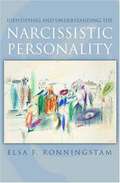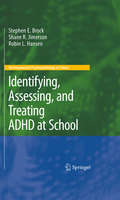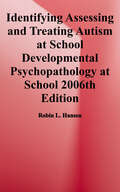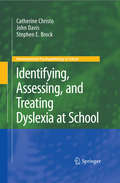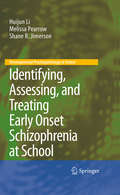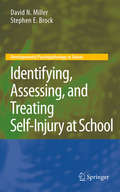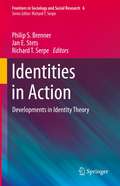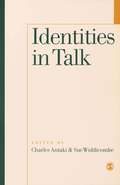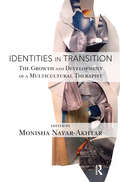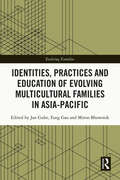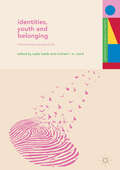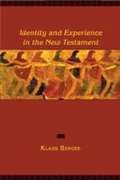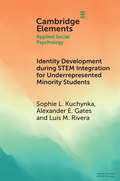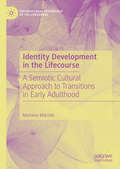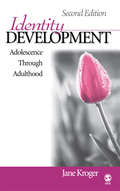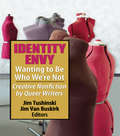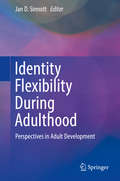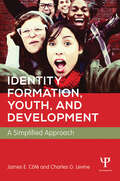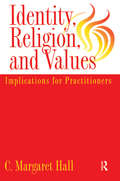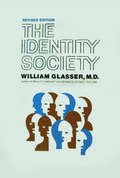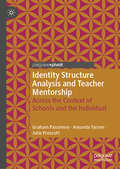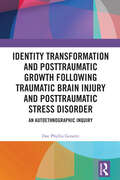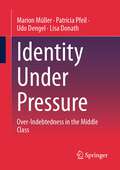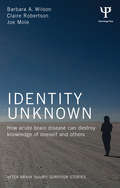- Table View
- List View
Identifying and Understanding the Narcissistic Personality
by Elsa F. RonningstamNarcissists have been much maligned, but according to clinicians who study personality, there are many productive narcissists who succeed spectacularly well in life because they can articulate a vision and make others follow. Elsa Ronningstam, who has been studying and treating narcissists for 20 years, presents a balanced, comprehensive, and up-to-date review of our understanding of narcissistic personality disorder, explaining the range from personality trait, which can be productive, to full-blown disorder, which can be highly destructive. Through fascinating case histories, Ronningstam shows us the inner life of narcissists, the tug of war that exists within them between self-confidence and arrogance on the one hand and painful shame and insecurity on the other. It is the first integrated clinical and empirical guide to assist clinicians in their work with narcissistic patients.
Identifying, Assessing, and Treating ADHD at School
by Stephen E. Brock Robin L. Hansen Shane R. JimersonADHD is the most commonly diagnosed childhood behavioral disorder. Moreover, many students receiving special education assistance are reported to have ADHD. Children with ADHD may experience significant school adjustment difficulties and achievement problems. Problem behaviors associated with attention deficits and hyperactivity often have a negative impact on the classroom, and, therefore, may compromise the learning environment for many, if not all, students. There is a critical need for school professionals to identify, assess, and treat students with ADHD. Identifying, Assessing, and Treating ADHD at School brings science to practice, providing school professionals invaluable information to meet the needs of children with ADHD. This volume, designed as a practical, easy-to-use reference for school psychologists and other mental health and educational professionals: Explains why school psychologists and their colleagues need to be prepared and able to identify and serve students with ADHD. Identifies the prevalence, influences, and associated conditions. Provides a review of screening, referral, and diagnostic assessment processes. Offers guidance on conducting psychoeducational assessments. Reviews evidence-based treatments. Offers practical guidance on setting up programs that address individual and classroom issues. School psychologists and other education and mental health professionals will find Identifying, Assessing, and Treating ADHD at School an exceptional resource in working to enhance the mental health and academic development of students.
Identifying, Assessing, and Treating Autism at School (Developmental Psychopathology At School Ser.)
by Robin L. HansenThere is no other recently published book on this topic dedicated to school psychologists and other educational professionals. Focuses on the assessment, identification, and treatment of students in the school context. Unlike competing works, this would be an authored (not edited) volume and will, therefore, be much more focused and specific.- This book will be very practical and applied in its orientation. It will give readers direction that they can immediately follow in their school-based practice.- This book will clearly identifies the roles and responsibilities of educational professionals and school psychologists in identification of students with autism.
Identifying, Assessing, and Treating Bipolar Disorder at School
by Stephen E. Brock Shelley R. Hart Ida JeltovaIdentifying, Assessing, and Treating Bipolar Disorder at School presents child and education practitioners with an evidence-based framework for accurate identification, assessment, and intervention of bipolar disorder. This straightforward resource clears up misconceptions about the condition, and outlines its complex presentation in young people, where it may appear in tandem with other disorders and bring challenges to treatment. By providing information to assist in referrals, consultations, and recommendations for special education, the authors give the reader a unique vantage point for improving students' learning environment and helping to facilitate the work of fellow professionals. Among the topics: Prevalence and associated conditions. Case finding, screening, and referrals. Diagnostic and psycho-educational assessment Treatment of bipolar disorder in children and adolescents. Plus suggested resources to assist students and their families. Identifying, Assessing, and Treating Bipolar Disorder at School is an essential reference for school psychologists and allied educational professionals, special education teachers, speech and language therapists, counselors, clinical child psychologists, and mental health practitioners.
Identifying, Assessing, and Treating Dyslexia at School
by John M. Davis Catherine Christo Stephen E. BrockAs many as one in four children experiences problems with reading. Dyslexia, the most common learning disability leads to well-documented negative effects on school and, ultimately, adult success. Therefore, it is critical that school professionals provide early and effective assessment and intervention. Identifying, Assessing, and Treating Dyslexia at School equips practitioners with in-depth understanding of the disorder and a wealth of practical information for meeting student needs. This volume: Reviews up-to-date findings on dyslexia - causes, prevalence, and related conditions. Provides research-based tools for identifying and addressing dyslexia. Offers a detailed framework for case finding and screening, diagnostic and psychoeducational assessment as well as age- and grade-appropriate intervention. Explains the roles and responsibilities of school psychologists when it comes to identifying students with dyslexia. Focuses solely on dyslexia, unlike most other books on learning disabilities. As the duties of school psychologists and related education professionals become more complex, recognizing and providing services for students with learning disorders has become progressively more demanding. Identifying, Assessing, and Treating Dyslexia at School offers practitioners an accessible and easy-to-read reference that they will use for years to come.
Identifying, Assessing, and Treating Early Onset Schizophrenia at School
by Shane R. Jimerson Melissa Pearrow Huijun LiBy itself or in combination with an affective disorder, early onset schizophrenia (EOS) -- the onset of symptoms before 18 years of age -- can create severe deficits in young people's academic performance, family and peer relationships, and even the ability to acquire new skills. The relative rarity of the condition, meanwhile, can leave school personnel unsure of how to meet -- or even recognize -- student needs. Identifying, Assessing, and Treating Early Onset Schizophrenia at School emphasizes the importance of providing teachers and students alike with the support needed to enhance academic performance and improve social skills of children and adolescents with EOS within educational settings. In addition, its evidence-based framework enables school professionals to achieve greater confidence and accuracy in identifying students with EOS and provide appropriate services, both in special education and general classes. In this authoritative and accessible volume, experts offer the most salient information on early onset schizophrenia, including: Contributing factors and risk factors.Prevalence and epidemiology.Screening and assessment procedures.Guidelines for determining eligibility for special education programs under IDEIA and Section 504.Latest findings on school-based and off-campus interventions for EOS.A useful resource appendix.Identifying, Assessing, and Treating Early Onset Schizophrenia at School gives school psychologists and allied education professionals both a practical understanding of this disabling condition and the most up-to-date strategies for providing earlier and effective interventions.
Identifying, Assessing, and Treating Self-Injury at School
by Stephen E. Brock David N. MillerNonsuicidal self-injury (NSSI) among young people--most notably in the form of forearm- or wrist-cutting--occurs across cultural groups, social strata, and developmental stages, puzzling and repelling adults. Youth engaging in NSSI behaviors are at a higher risk for suicidality as well as other mental health and academic problems. And because NSSI is often first noticed in the school setting (as is the case with many children's disorders), school professionals are being encouraged to take a more proactive role in intervention. The first book specifically geared toward education personnel, Identifying, Assessing, and Treating Self-Injury at School clearly defines NSSI, differentiating it from suicidal, borderline, and other behaviors and analyzing the psychological contexts in which it occurs. This school-based perspective gives readers a practical framework for earlier, more accurate diagnosis; relevant consulting with parents, teachers, and colleagues; and effective, science-based treatment. Included in the coverage: an overview of causes of self-injury, current findings on prevalence and associated conditions, early screening guidelines, including risk factors and warning signs, the latest information on assessment issues and diagnostic methods, a separate chapter on psychoeducational assessment and up-to-date research on interventions for NSSI. Identifying, Assessing, and Treating Self-Injury at School offers a solid foundation for school psychologists and allied educational professionals to understand students with NSSI and address their complex needs.
Identities in Action: Developments in Identity Theory (Frontiers in Sociology and Social Research #6)
by Jan E. Stets Richard T. Serpe Philip S. BrennerThis volume presents recent developments in identity theory and research. Identities are the basic building blocks of society and hold a central place in every social science discipline. Identity theory provides a systematic conceptualization of identities and their relationship to behavior. The research in this volume demonstrates the usefulness of this theory for understanding identities in action in a variety of areas and settings. The volume is organized into three general areas: ethnicity and race; family, religion, and work; and networks, homophily, and the physical environment. This comprehensive and authoritative volume is of interest to a wide readership in the social and behavioral sciences, including students and researchers of sociology, social psychology, psychology, and other social science disciplines.
Identities in Talk
by Charles Antaki Sue Widdicombe`Identity' attracts some of social science's liveliest and most passionate debates. Theory abounds on matters as disparate as nationhood, ethnicity, gender politics and culture. However, there is considerably less investigation into how such identity issues appear in the fine grain of everyday life. This book gathers together, in a collection of chapters drawing on ethnomethodology and conversation analysis, arguments which show that identities are constructed `live' in the actual exchange of talk. By closely examining tapes and transcripts of real social interactions from a wide range of situations, the volume explores just how it is that a person can be ascribed to a category and what features about that category are consequential for the interaction.
Identities in Transition: The Growth and Development of a Multicultural Therapist
by Monisha Nayar-AkhtarIdentities in Transition is a book about the growth and development of a multicultural therapist/analyst. Hailing from all around the world (Argentina, England, Egypt, India, Israel, Iran, Lebanon, New Zealand, Mexico, Nigeria, Puerto Rico, Poland), the contributing therapists share their personal stories of clinical minds at work. The factors that inform them are varied and diverse, shaped by their histories of immigration and professional training. Insightful and thought provoking, their explorations capture the struggles, the dilemmas and the skillful integration of various parts of themselves, that finds expression in clinical encounters and analytic settings. Their sensitive reflections upon the salient features of their didactics, supervision and personal analyses, provides a blue print for an adaptive and assimilative process at work. The nuanced impact of immigration, of diversity of culture, of thought and conduct and the integrative process is highlighted. In the process these clinicians develop a 'voice' as unique as their past, informed by thoughtful reflections of their training and the assimilative process.
Identities, Practices and Education of Evolving Multicultural Families in Asia-Pacific (Evolving Families)
by Jan GubeThis edited book highlights the identities and practices of ethnically diverse families and schools in contexts where multicultural policies are not always a priority. In an era of globalization and ensuing population mobility, it places a focus on Asia-Pacific, a continent with diverse customs, populations, and languages, but grapples with what it might mean to be multicultural. The book features studies and frameworks that illustrate how minoritized communities engage with the diversity they live in and strategies in adjusting and adapting to their sociocultural environments, including practices that might support these efforts. This book represents initiatives and interdisciplinary scholarship from Japan, Hong Kong, mainland China, Australia, South Korea, Thailand, and Taiwan, which underscore the intersection of identities, cultural values, efforts, conflicts, and religions in making diversity work in their contexts. Collectively, these works make a unique contribution by invigorating debates on the flows and evolvement of cultural values and practices within and across families and institutions. This book will appeal to researchers, practitioners, and readers with interest in the current state of cultural diversity among minoritized families in Asia-Pacific and beyond.
Identities, Youth and Belonging: International Perspectives (Studies In Childhood And Youth Series)
by Sadia Habib Michael R. M. WardIdentities, Youth and Belonging
Identity And Experience In The New Testament
by Klaus Berger Charles Muenchow<P>How do the New Testament documents present issues of passion, will, identity, and perception? How did the earliest followers of Jesus understand their experiences, behaviors, and suffering? <P>These questions and more are addressed in this stimulating work by one of the most productive Continental New Testament scholars. Rather than approaching the New Testament with a Freudian, Jungian, or other modern psychological theory, Berger illuminates historically how peoples of the first century described their human experiences in relation to their encounters with God, Christ, demons, and the power of their own desires and will.
Identity Development during STEM Integration for Underrepresented Minority Students (Elements in Applied Social Psychology)
by Sophie L. Kuchynka Alexander E. Gates Luis M. RiveraOver the past three decades, research efforts and interventions have been implemented across the United States to increase the persistence of underrepresented minority (URM) students in science, technology, engineering, and math (STEM). This Element systematically compares STEM interventions that offer resources and opportunities related to mentorship, research, and more. We organize the findings of this literature into a multi-phase framework of STEM integration and identity development. We propose four distinct phases of STEM integration: Phase 1: High School; Phase 2: Summer before College; Phase 3: First Year of College; and Phase 4: Second Year of College through Graduation. We combine tenets of theories about social identity, stereotypes and bias, and the five-factor operationalization of identity formation to describe each phase of STEM integration. Findings indicate the importance of exploration through exposure to STEM material, mentorship, and diverse STEM communities. We generalize lessons from STEM interventions to URM students across institutions.
Identity Development in the Lifecourse: A Semiotic Cultural Approach to Transitions in Early Adulthood (Sociocultural Psychology of the Lifecourse)
by Mariann MärtsinThis book offers a unique developmental perspective on identity construction in the context of mobility and transition to adulthood. Drawing upon semiotic cultural psychology, it embeds identity construction into the processes of meaning making; viewing identity as a field of hyper-generalised signs that are constantly reconstructed through encounters with social others in cultural worlds, and which allow individuals to make sense of themselves in relation to their lived pasts, experienced presents and imagined futures. Märtsin invites the reader to travel with eight young adults as they embark on their developmental journeys and seek to make sense of issues that matter most to them: home, adventure and belonging, friendships, recognition, and future-planning. The book is an invaluable resource for students and researchers interested in understanding the experiences of emerging adults in contemporary globalized world, but also for those interested in identity processes from a semiotic, cultural and developmental perspective.
Identity Development: Adolescence Through Adulthood (Second Edition)
by Professor Jane KrogerThis volume highlights identity development from early adolescence through late adulthood and provides a valuable resource for university students as well as human services professionals. This Second Edition of Identity Development: Adolescence Through Adulthood presents an overview of the five general theoretical orientations to the question of what constitutes identity, as well as the strengths and limitations of each approach. The volume then describes key biological, psychological, and contextual issues during each phase of adolescence and adulthood. Following these major adolescence and adulthood sections, selected issues that may pose identity challenges for some are presented.
Identity Envy Wanting to Be Who We're Not: Creative Nonfiction by Queer Writers
by Jim Tushinski Jim Van BuskirkGay men and lesbians present humorous and hard-hitting accounts of the need to belong . . . somewhere Why would a lesbian raised in a Jewish home have a sudden desire to be a tough-talking Catholic girl? And why would a gay man travel to Ireland in a desperate attempt to escape his "hillbilly" roots? Identity Envy-Wanting to Be Who We&’re Not explores the connections gay men and lesbians have to religions, races, ethnicities, classes, families of origin, and genders not their own. This unique anthology takes both humorous and serious looks at the identities of others as queer writers explore their own identity envies in personal essays, memoirs, and other creative nonfiction.Gay men, lesbians, bisexuals, transgendered, intersex, and other sexual minorities often feel marginalized by mainstream culture and have a need to belong somewhere, to claim a group as their own. This surprising book presents stories of identity envy that are humorous and hard-hitting, poignant and provocative, written with energy, wit, and candor by many of your favorite writers-and some exciting newcomers. Identity Envy-Wanting to Be Who We&’re Not includes: Gerard Wozek&’s King Fu-infused "Chasing the Grasshopper" Max Pierce&’s fantasy of being a "Child Star" that helped him through a troubled family life Lori Horvitz&’s "Shiksa in my Living Room" D. Travers Scott's "EuroTex"Perry Brass's "A Serene Invisibility: Turning Myself into a Christian Girl" Jim Tushinski&’s ode to Lost in Space, "The Perfect Space Family" Al Cho&’s unlikely identification with Laura Ingalls Wilder characters, "Farmer Boy" Irish-American John Gilgun wishes he could be one of those "Italian-American Boys" Joan Annsfire rejects her Jewish heritage to become Catholic schoolgirl Corinne O'Donnell in "The Promise of Redemption" Andrew Ramer&’s "Tales of a Male Lesbian" city slicker Mike McGinty&’s life with the cattle folk, "You Picked a Fine Time to Leave Me, Helen" and much more!Identity Envy-Wanting to Be Who We&’re Not is a must-read for anyone who appreciates good writing-especially gay and lesbian readers who know what it&’s like to wish you were someone else.
Identity Flexibility During Adulthood
by Jan D. SinnottThis volume seeks to explore the idea of identity as a flexible center of events around which aspects of the self and events in the outside world are organized. Historically, in much of the literature, identity was conceptualized as a somewhat fixed, unchanging construct. Scholars now have a greater awareness of more nuanced theories about identity and there is a greater willingness to accept that identity is not fixed, concrete, and permanent, but rather evolving and fluid. Although this volume discusses a wide variety of aspects of identity as it flexibly changes during adulthood in the face of numerous experiences, it is really addressing one key question. How adaptive and fluid is identity and how can we know ourselves as both continuing and changing? Exploring these ideas raises the importance of future research on adult identity. With a firm grounding in the historical and theoretical background of identity research, this volume begins by defining identity and the psychological "self" as a center around which the person's behaviors and self-concepts revolve. The following chapters gather the wisdom of many writers who all accepted the challenge of talking about creating a flexible adult self and identity during adulthood. They come at this challenging question from many different perspectives using different tools. Some survey existing literature and theory, then summarize prior work in a meaningful way. Some discuss their own research; some reflect on personal experiences that have demanded a flexible identity. Also included in the coverage are discussions of methodology and validity issues for studies and scales of identity. With its dual focus on research and applied fields ranging across social and personality psychology, industrial/occupational psychology, cross-cultural psychology, mental health, existential issues, relationships, and demographic categories, Identity Flexibility During Adulthood: Perspectives on Adult Development is a fascinating and complex resource for psychologists, sociologists, anthropologists, gerontologists, and all those interested in our changing identities.
Identity Formation, Youth, and Development: A Simplified Approach
by James E. Cote Charles LevineThe concept of identity is one of the most important ideas the social sciences have investigated in recent years, yet no introductory textbooks are available to those who want to gain a sense of this burgeoning field. The first of its kind, this text provides an introduction to the scientific study of identity formation, with a focus on youth development. The analyses of the problems and prospects faced by contemporary young people in forming identities are placed in the context of societies that themselves are in transition, further complicating identity formation and the interrelated processes of self development and moral-ethical reasoning. In order to sort through what is now a vast literature on the various aspects of human identity, this book introduces the Simplified Identity Formation Theory. This theory cuts through much of the academic jargon that limits the accessibility of this promising field, and builds an understanding of human identity from first principles. This book is optimized for students and instructors, featuring several useful pedagogical tools and a robust series of online resources: Primer format: the text synthesizes the vast and disparate literature that has characterized the field of Identity Studies, with a focus on identity formation during the transition to adulthood; theory and research is discussed in plain, non-technical language, using the author’s new Simplified Identity Formation Theory. In-text pedagogy: to enhance student engagement, box insert and in-text examples from current events, popular culture, and social media are incorporated throughout the text; key terms are in bold in each chapter and combined in a glossary at the end of the text. Online resources for instructors: A robust set of resources that, when combined with the text, provides a complete blueprint for designing an identity course; resources include PowerPoint Presentations, test bank, sample syllabi, and instructor manuals for both face-to-face and online courses that include weekly written assignment questions and discussion-forum questions along with essay topic ideas and grading rubrics. Online resources for students: a student manual, flashcards, practice quizzes, and exercises with video links.
Identity Religion And Values: Implications for Practitioners
by C. Margaret HallDesigned for professionals, this handbook focuses on the impact of patients' religion snd spirituality. It presents the identity empowerment theory, a clinical sociological theory, and includes case studies and intervention strategies.
Identity Society
by William GlasserThis interesting societal study by the father of Reality Therapy presents a view that since survival is no longer the major issue for humans, development of self and identity is a normal social quest.
Identity Structure Analysis and Teacher Mentorship: Across the Context of Schools and the Individual
by Graham Passmore Amanda Turner Julie PrescottThis book examines the benefits of applying the Identity Structure Analysis (ISA) to teacher professional development. At present no government, local authority or school is actively applying Identity Structure Analysis to monitor school improvement: in a profession where turnover is extremely high, ISA is framed as a way for professional development to meet the needs of the specific teacher. Examining idiographic ISA analyses as well as practical advice for implementing professional development programs, the authors scrutinise how ISA can be used in conjunction with mentoring to offset teacher turnover. This practical volume will be of interest and value to scholars and researchers of teacher identity and professional development, as well as researchers and policymakers interested in reducing teacher turnover.
Identity Transformation and Posttraumatic Growth Following Traumatic Brain Injury and Posttraumatic Stress Disorder: An Autoethnographic Inquiry
by Dee Phyllis GenettiIdentity Transformation and Posttraumatic Growth Following Traumatic Brain Injury and Posttraumatic Stress Disorder provides an autoethnographic qualitative study that portrays the author’s recovery from a devastating life-changing event – a car crash resulting in the hybrid diagnosis of traumatic brain injury (TBI) and posttraumatic stress disorder (PTSD), leading to posttraumatic growth ( PTG) and identity transformation over a ten-year recovery period. In so doing, the text offers a comprehensive literature review on TBI, PTSD, PTG and disability culture. Throughout, the author explores whether growth (PTG) and distress (PTSD) and whether TBI and PTSD can co-exist. Having lost her ability to read and write, the author had to learn how to learn, to heal and to have faith again. As a licensed trauma therapist and researcher, she collected self-observational data by writing her actual behaviors, thoughts and emotions in real time, both in a field and a process journal, even before she could write in full sentences. The many symptoms and co-morbidities of TBI and PTSD and the tenets of PTG are portrayed as they evolved in recovery showing the behaviors and characteristics of each. The text refers to actual journal entries, medical records and clinical notes from rehabilitation specialists, alternating between her clinical analysis and interpretation. The findings show that tragedy and suffering can lead to growth and positive change (PTG) after TBI, even though the precipitating trauma and psychological distress (PTSD) may persist for years. Changes are seen in self-perception, interpersonal relationships and philosophies of life. This chronicled account of the author’s emergent recovery from patient to doctor is intended to benefit neuro-rehabilitation service providers (neuropsychologists, primary care physicians, speech-language pathologists) and also mental health clinicians who can see the evolution of PTG for what is now the new next step for many in PTSD recovery.
Identity Under Pressure: Over-Indebtedness in the Middle Class
by Marion Müller Patricia Pfeil Udo Dengel Lisa DonathThe authors examine identity strategies of middle-class couples who come under pressure of over-indebtedness. Based on biographical interviews collected in a qualitative panel study in three waves, they explore the question of how identity is worked on in the couple and how identity changes when social decline threatens. The theory-generating analysis brings out patterns of coping with over-indebtedness and self-placement described along the notions of 'continuity', 'modification' and 'moratorium'. Similarly, they explore how lifeworlds are constructed in and with over-indebtedness as a couple.This book is a translation of an original German edition. The translation was done with the help of artificial intelligence (machine translation by the service DeepL.com). A subsequent human revision was done primarily in terms of content, so that the book will read stylistically differently from a conventional translation.
Identity Unknown: How acute brain disease can destroy knowledge of oneself and others (After Brain Injury: Survivor Stories)
by Barbara A. Wilson Claire Robertson Joe MoleImagine being unable to recognise your spouse, your children, or even yourself when you look in the mirror, despite having good eyesight and being able to read well and name objects. This is a condition which, in rare cases, some brain injury survivors experience every day. Identity Unknown gives an exceptional, poignant and in-depth understanding of what it is like to live with the severe after-effects of brain damage caused by a viral infection of the brain. It tells the story of Claire, a nurse, wife, and mother of four, who having survived encephalitis, was left with an inability to recognise faces – a condition also known as prosopagnosia together with a loss of knowledge of people and more general loss of semantic memory Part One describes our current knowledge of encephalitis, of perception and memory, and the theoretical aspects of prosopagnosia and semantic memory. Part Two, told in Claire’s own words, is an account of her life before her illness, her memories of the early days in hospital, an account of the treatment she received at the Oliver Zangwill Centre, and her description of the long-term consequences of encephalitis. Claire’s profound insights, clear writing style, and powerful portrayal of her feelings provide us with a moving insider’s view of her condition. These chapters also contain additional commentary from Barbara Wilson, providing further detail about the condition, treatment possibilities, potential outcomes, and follow-up options. Identity Unknown provides a unique personal insight into a condition which many of us have, for too long, known too little about. It will be of great interest to a broad audience including professionals working in rehabilitation settings, and all those who have sustained a brain injury, their families and carers.
